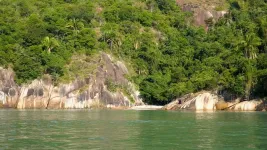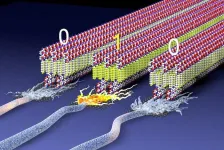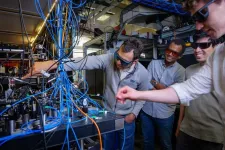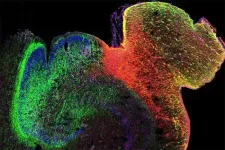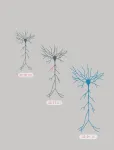(Press-News.org) Sea surface temperature, wave energy and freshwater discharge from rivers influence the abundance and size of the marine organisms that inhabit rocky shores along the coast of Southeast Brazil more than ecological processes such as competition and predation. In areas where the water is colder, such as the Lakes Region (Região dos Lagos) in Rio de Janeiro state, marine organisms are 25%-100% larger than in areas where it is warmer, such as the coast of São Paulo state.
These are the main conclusions of a study conducted by researchers affiliated with the Federal University of São Paulo (UNIFESP) in partnership with colleagues at the State University of Northern Rio de Janeiro (UENF) and the University of São Paulo’s Center for Marine Biology (CEBIMAR-USP) in Brazil, as well as research institutions in other countries. The study was supported by FAPESP. The results are reported in an article published in the journal Marine Environmental Research.
According to the researchers, the findings can also be used to help estimate the potential effects of climate change on marine biodiversity. “Understanding the impact of climate change on biodiversity is a challenge because of the vast spatial scale on which the events in question play out, the difficulty of including all these factors in the design of controlled experiments, and the fact that they may vary significantly over time,” Ronaldo Christofoletti, a researcher at UNIFESP‘s Institute of Marine Sciences (IMAR) and last author of the article, told Agência FAPESP.
The researchers assessed the influence of environmental factors, such as substrate topography, wave exposure and sea surface and air temperatures, as well as ecological variables, such as predation, on the population structure of the main species of marine organisms inhabiting rocky shores in an area of more than 800 km between Itanhaém in São Paulo state and Armação dos Búzios in Rio de Janeiro state. The area corresponds to more than 50% of Brazil’s rocky (as opposed to sandy) coastline.
The first stage of the study consisted of field campaigns to collect data from 62 rocky shores with the aim of ensuring that all the indicators were under the influence of the same seasonal climate regime. Other data collection campaigns were conducted as a basis for analyzing predation among the main species, as well as experiments at 18 rocky shore sites to find out how climate change could influence predatory relations among the animals concerned.
In parallel with the fieldwork and analysis of organisms in the laboratory, the researchers conducted satellite-based remote sensing surveys to collect data with which to model sea surface temperature, coastal freshwater discharge and wave impact in order to understand how each of these factors varied on a scale of less than 10 km along the coast.
The results of the analysis showed that most of the species studied were smaller in areas of warmer water – from the Baixada Santista in São Paulo state (a metropolitan area named after the port city of Santos) to the south coast of Rio de Janeiro state, for example – than in areas of colder water, such the Lakes Region. Filter feeders such as barnacles and mussels were 25%-35% larger, carnivores up to 50% larger, and herbivores 100%-130% larger in colder water.
One explanation for the link between water temperatures and size, according to the researchers, may be that animals tend to reach sexual maturity more quickly in warmer water so that they spend less time investing energy in growth and reach a smaller size, but then invest more energy in reproduction. In addition, the Lakes Region is influenced by an upwelling that sweeps nutrients from the seabed to the surface and may offer the food chain more energy.
“The results didn’t show that food supply was a limitation in any area, as there was always prey available, but the fact that there were more nutrients in some areas may exert an influence in terms of contributing to faster growth. This hypothesis was to have been tested during the project but it was interrupted by the COVID-19 pandemic and couldn’t be resumed later,” Christofoletti explained.
Effects of climate change
The researchers also set out to discover how the populations of marine organisms diversify in a natural environment with a sea surface temperature gradient of about 3 °C between the warm-water area from Baixada Santista in São Paulo to Ilha Grande in Rio de Janeiro and cold-water areas such as the Lakes Region. Understanding how this temperature gradient influences the natural environment, they felt, could help predict the potential effects of ocean warming, which reached 1 °C-2 °C above average in 2023 in the South Atlantic.
The researchers sought rocky shores with this temperature gradient and differing degrees of wave impact in Brazil’s Southeast region, ranging from sheltered areas with weak wave energy to areas exposed to strong wave energy. This enabled them to gauge the local effect of wave exposure as well as the influence of sea surface temperature. “We had a chance to see how storm surges and rip tides affect biodiversity, for example” Christofoletti said.
In areas where wave energy was a stronger influence, barnacles were 50% more abundant, while mussels and Stramonita brasiliensis (a species of sea snail or whelk) were three times as abundant. One explanation for this is that the stronger waves boosted the supply of nutrients via larvae and other food sources.
An experiment conducted during the study of rocky shores showed that barnacles preyed less on S. brasiliensis in areas where wave energy was a stronger influence because the waves frequently drove predators off the rocks. Predation was more significant in areas where wave energy was lower, prey was less abundant, and predators fed more efficiently because the waves were not a hindrance.
“In a scenario characterized by rising sea levels and more frequent extreme events, the results show that these organisms may become more abundant but will face harder challenges to feed efficiently, potentially leading to an ecological imbalance. This is even more likely in the context of sea surface warming, where they will also tend to become smaller. The outcome could be a comprehensive change in natural populations in this environment,” said André Pardal, a professor at UNIFESP and second author of the article.
They also selected rocky shore sites near to and far from river mouths to find out how freshwater discharge influenced marine biodiversity. Climate change has included periods of extreme rainfall resulting in higher levels of freshwater discharge into the ocean from rivers, the researchers note.
“In the context of climate change, a rocky shore near a river mouth from which freshwater discharge increases owing to heavy rain, and which is exposed to stronger waves and warmer water, will see an increase in mussels and a decrease in predation of them, so that they become more abundant, dominate the space, and alter the natural biodiversity in this environment. That’s an example focusing on a single species,” Christofoletti said.
About São Paulo Research Foundation (FAPESP)
The São Paulo Research Foundation (FAPESP) is a public institution with the mission of supporting scientific research in all fields of knowledge by awarding scholarships, fellowships and grants to investigators linked with higher education and research institutions in the State of São Paulo, Brazil. FAPESP is aware that the very best research can only be done by working with the best researchers internationally. Therefore, it has established partnerships with funding agencies, higher education, private companies, and research organizations in other countries known for the quality of their research and has been encouraging scientists funded by its grants to further develop their international collaboration. You can learn more about FAPESP at www.fapesp.br/en and visit FAPESP news agency at www.agencia.fapesp.br/en to keep updated with the latest scientific breakthroughs FAPESP helps achieve through its many programs, awards and research centers. You may also subscribe to FAPESP news agency at http://agencia.fapesp.br/subscribe.
END
Effects of environmental factors on Southeast Brazil’s coastal biodiversity surpass those of ecological processes
Marine organisms in areas influenced by lower sea surface temperatures, such as the Lakes Region in Rio de Janeiro state, are between 25% and 100% larger than those inhabiting warmer water along the coast of São Paulo state, the study shows.
2024-10-09
ELSE PRESS RELEASES FROM THIS DATE:
Department of Energy announces $49 million for research on foundational laboratory fusion
2024-10-09
WASHINGTON, D.C. - As the Department of Energy (DOE) continues to accelerate a clean-energy future that includes fusion technology, a total of $49 million in funding for 19 projects was announced today in the Foundational Fusion Materials, Nuclear Science, and Technology programs.
The purpose of the funding is to reorient the laboratory-based foundational and basic science research programs to better align and support the new FES program vision.
“The Fusion Nuclear Science Foundational research program, ...
Effects of exposure to alcohol in early pregnancy can be detected in the placenta
2024-10-09
A new study led by Pr. Serge McGraw, researcher at CHU Sainte-Justine and professor at Université de Montréal, shows that the effects of alcohol exposure on an embryo prior to implantation in the uterus can be detected in the late-gestation placenta. Using a mouse model well suited for this type of exposure, the researcher and his team observed significant molecular changes in the placenta, including the expression of numerous genes and DNA methylation, an epigenetic marker that influences gene expression by ...
Scientists caution no guarantees when it comes to overshooting 1.5°C
2024-10-09
Even if it is possible to reverse the rise of global temperatures after a temporary overshoot of 1.5°C, some climate damages inflicted at peak warming, including rising sea levels, will be irreversible, according to a new study published today in Nature.
The study is the culmination of a three-and-a-half-year project, backed by the European innovation fund HORIZON2020, looking at so-called ‘overshoot’ scenarios where temperatures temporarily exceed the Paris Agreement’s 1.5°C ...
Nature and plastics inspire breakthrough in soft sustainable materials
2024-10-09
Step aside hard, rigid materials. There is a new soft, sustainable electroactive material in town — and it’s poised to open new possibilities for medical devices, wearable technology and human-computer interfaces.
Using peptides and a snippet of the large molecules in plastics, Northwestern University materials scientists have developed materials made of tiny, flexible nano-sized ribbons that can be charged just like a battery to store energy or record digital information. Highly energy efficient, biocompatible and made from sustainable materials, the systems could give rise to new ...
New quantum timekeeper packs several clocks into one
2024-10-09
Imagine walking into a room where several different grandfather clocks hang on the walls, each ticking at a different pace.
Quantum physicists at the University of Colorado Boulder and the National Institute of Standards and Technology (NIST) have essentially recreated that room at the scale of atoms and electrons. The team’s advancement could pave the way for new kinds of optical atomic clocks, devices that track the passage of time by measuring the natural “ticking” of atoms.
The group’s new clock is made from a few dozen strontium ...
Suicidal thoughts and behaviors among autistic transgender or gender-nonconforming US college students
2024-10-09
About The Study: This cross-sectional study addresses the dearth of information on how intersectionality in gender and autism status impacts the risk of suicidal thoughts and behaviors, and the results confirm the elevated risk of suicidal thoughts and behaviors among transgender or gender nonconforming and autistic populations. Interventions are needed to support college students with these identities.
Corresponding Author: To contact the corresponding author, Annabelle M. Mournet, MS, email amm883@psych.rutgers.edu.
To ...
The bright and dark sides of Pacific salmon biotransport
2024-10-09
Each year millions of Pacific salmon make a grand journey from the ocean to their freshwater spawning grounds at the end of their life cycles. This migration has rippling effects through food webs and ecosystems along the way. Whether they decompose or are consumed by other animals, these salmon deliver both nutrients and contaminants they have accumulated in their bodies after spending most of their lives growing at sea. A team of researchers from UConn, the University of South Dakota, the U.S. Geological Survey, Natural ...
New therapeutic strategy identified for triple negative breast cancer
2024-10-09
Triple negative breast cancer (TNBC) remains the most aggressive and deadly type of breast cancer, but new findings from cancer researchers at Brigham and Women’s Hospital, a founding member of the Mass General Brigham healthcare system, are pointing the way toward therapeutic strategies that could be tested in clinical trials in the future. Using patient-derived samples in pre-clinical work, researchers discovered that by combining two therapeutic agents they could nudge TNBC cells into a more treatable state. Findings are published in Nature.
“When combined, these therapeutic agents ...
Scientists create first map of DNA modification in the developing human brain
2024-10-09
A UCLA-led study has provided an unprecedented look at how gene regulation evolves during human brain development, showing how the 3D structure of chromatin — DNA and proteins — plays a critical role. This work offers new insights into how early brain development shapes lifelong mental health.
The study, published in Nature, was led by Dr. Chongyuan Luo at UCLA and Dr. Mercedes Paredes at UC San Francisco, in collaboration with researchers from the Salk Institute, UC San Diego and Seoul National University. It created the first map of DNA modification in the hippocampus and prefrontal cortex — two regions ...
Extended Timing: How neurons encode information on timescales that match learning
2024-10-09
New research from the Max Planck Florida Institute for Neuroscience published this week in Nature has identified a key step in how neurons encode information on timescales that match learning.
A timing mismatch
Learning takes seconds to minutes. However, the best-understood mechanisms of how the brain encodes information happen at speeds closer to neural activity—around 1000 times faster. These mechanisms, known as Hebbian plasticity, suggest that if two connected neurons are both active within a hundredth of a second, then the connection between the two neurons is strengthened. In this ...
LAST 30 PRESS RELEASES:
Tracing the quick synthesis of an industrially important catalyst
New software sheds light on cancer’s hidden genetic networks
UT Health San Antonio awarded $3 million in CPRIT grants to bolster cancer research and prevention efforts in South Texas
Third symposium spotlights global challenge of new contaminants in China’s fight against pollution
From straw to soil harmony: International team reveals how biochar supercharges carbon-smart farming
Myeloma: How AI is redrawing the map of cancer care
Manhattan E. Charurat, Ph.D., MHS invested as the Homer and Martha Gudelsky Distinguished Professor in Medicine at the University of Maryland School of Medicine
Insilico Medicine’s Pharma.AI Q4 Winter Launch Recap: Revolutionizing drug discovery with cutting-edge AI innovations, accelerating the path to pharmaceutical superintelligence
Nanoplastics have diet-dependent impacts on digestive system health
Brain neuron death occurs throughout life and increases with age, a natural human protein drug may halt neuron death in Alzheimer’s disease
SPIE and CLP announce the recipients of the 2025 Advanced Photonics Young Innovator Award
Lessons from the Caldor Fire’s Christmas Valley ‘Miracle’
Ant societies rose by trading individual protection for collective power
Research reveals how ancient viral DNA shapes early embryonic development
A molecular gatekeeper that controls protein synthesis
New ‘cloaking device’ concept to shield sensitive tech from magnetic fields
Researchers show impact of mountain building and climate change on alpine biodiversity
Study models the transition from Neanderthals to modern humans in Europe
University of Phoenix College of Doctoral Studies releases white paper on AI-driven skilling to reduce burnout and restore worker autonomy
AIs fail at the game of visual “telephone”
The levers for a sustainable food system
Potential changes in US homelessness by ending federal support for housing first programs
Vulnerability of large language models to prompt injection when providing medical advice
Researchers develop new system for high-energy-density, long-life, multi-electron transfer bromine-based flow batteries
Ending federal support for housing first programs could increase U.S. homelessness by 5% in one year, new JAMA study finds
New research uncovers molecular ‘safety switch’ shielding cancers from immune attack
Bacteria resisting viral infection can still sink carbon to ocean floor
Younger biological age may increase depression risk in older women during COVID-19
Bharat Innovates 2026 National Basecamp Showcases India’s Most Promising Deep-Tech Ventures
Here’s what determines whether your income level rises or falls
[Press-News.org] Effects of environmental factors on Southeast Brazil’s coastal biodiversity surpass those of ecological processesMarine organisms in areas influenced by lower sea surface temperatures, such as the Lakes Region in Rio de Janeiro state, are between 25% and 100% larger than those inhabiting warmer water along the coast of São Paulo state, the study shows.
